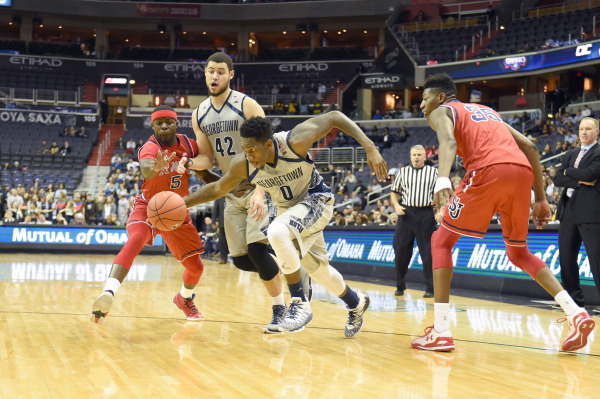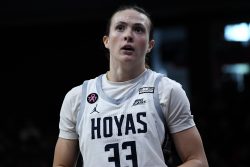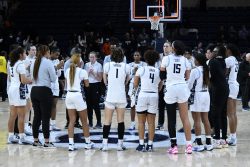Just one game into the 2015-16 Georgetown men’s basketball season, Coach John Thompson III was fumbling for the reset button.
His team had just been defeated by the Radford Highlanders, an unranked, mid-major opponent, in what was supposed to be a tune-up game for his Hoyas–who had entered the season with lofty postseason aspirations. Adding insult to injury was the fact that the loss came in double-overtime and in Georgetown’s home opener.
Though the game may have seemed like a fluke at the time, the Georgetown season ended in a similar manner to how it began, with hope for the restoration of one of college basketball’s most historic basketball programs suspended somewhere in the balance between delusion and optimism.
32 games and 17 losses after the team’s opening defeat, the cold winter helped Georgetown’s derailed season come to a skidding stop, but not without leaving its share of bumps and bruises. The Hoyas’ injury-ravaged, inexplicably inconsistent season was not just underwhelming, but historically bad. The Hoyas finished 7-11 in Big East Conference play and 15-18 overall, recording the program’s worst winning percentage (.455) since the 1971-72 season.
Finding a silver lining in Georgetown’s previous campaign remains a troublesome task, as even the team’s bright moments (which included an early season tournament win against Wisconsin and a come-from-behind victory against Creighton in conference play) were overshadowed by glaring, non-conference losses at home to Radford, Monmouth and UNC Asheville. Following an 81-67 drubbing in the Big East Quarterfinals at the hands of the Villanova Wildcats, Georgetown’s season ended without an appearance in the NCAA or NIT Tournament for the first time since Thompson took over the program in 2004.
For Thompson, last year offers lessons, but it cannot dominate the Hoyas’ mindset heading into the new campaign.
“It’s almost like it’s like a book that’s sitting in the corner of my desk,” Thomson said about the team’s memory of last season. “It’s there, you can think about it, you can remember it, you can learn from it, but we’re not going to keep rehashing [it].”
More than eight months since the final buzzer in Madison Square Garden shut the door on the ‘15-16 season, Thompson and the Hoyas have been granted a clean slate, and a chance to tackle a new season with plenty of new faces both on the court and in the coaching staff.
Hoping to fill the void left by last season’s leading scorer D’Vauntes Smith-Rivera who graduated in May, Georgetown bolstered its backcourt in the offseason by recruiting transfer guards Rodney Pryor and Jonathan Mulmore, each of whom is expected to carry a heavy load for the Hoyas on both ends of the court this season.
Pryor, who averaged 18.0 points and 8.0 rebounds per game for Robert Morris last season, offers the Hoyas a diverse skillset and the ability to play and guard multiple positions. Mulmore, a transfer from Allegany Junior College in Cumberland, Maryland, averaged 26.1 points and 5.9 assists per game, both good for the nation’s best, for the Trojans last season. In addition to the scoring punch these two guards will be expected to supply for the Blue and Gray this season, their athleticism and defensive fervor have contributed greatly to upping the intensity of offseason workouts leading up to the ‘16-17 season.
“The athleticism has increased a lot. Our practices are a lot more competitive, which is really great, relative to last year,” said Thompson. “It’s a difference when you bring in Jon and Rodney … They’ve quickly established a presence within our team, in the locker room and away from the court, which is very good.”
Georgetown’s backcourt was also boosted by the recruitment of freshman guard Jagan Mosely, who chose Georgetown after a standout senior season for at St. Anthony High School in Jersey City, New Jersey. Thompson has complimented the freshman guard’s maturity, and noted the depth that he provides to Georgetown’s backcourt—a luxury that the Hoyas lacked last season.
Mosely, Mulmore, and Pryor join a group of guards that also features junior returners LJ Peak and Tre Campbell, each of whom provided an occasional but inconsistent spark for the Hoyas last season. Peak was the second-leading scorer for the team last season with 12.9 points per game, shooting 40.9% from three-point range–a great improvement from the 24.6% that he averaged in his freshman year. Campbell’s statistics last season were modest, as he averaged 4.1 points and 1.7 assists per game, but the third-year point guard spent time as the team’s primary ball handler when Smith-Rivera rested on the bench.
Last season, the Hoyas were heavily reliant upon the outside shooting of Smith-Rivera, whose ability to demand attention at the perimeter helped Georgetown spread the floor on offense. This space allowed the Hoyas to take the second most 3-pointers of any Big East team last year, yet the team’s three-point shooting was almost as cold as a winter walk from Darnall to Leo’s. Georgetown only shot a better percentage from behind the arc (33.9%) than St. John’s (32.6%) and Providence (32.1%), and the team will rely upon its backcourt additions to add a much-needed punch from the outside in order for Thompson’s Princeton offense to work efficiently this season.
In the frontcourt, Georgetown will depend on the offseason development of several key returners, including sophomore center Jessie Govan, who has been mentioned by DraftExpress.com as a first-round NBA prospect, and sophomore forward Marcus Derrickson. These two big men were solid offensive contributors last season, and have put in significant time this offseason refining their defensive games.
“All last year, that’s all I had, my jump shot, so this year was a focus on developing other things while keeping my jump shot,” said Derrickson, who shot 37.6% from the three, and 86.9% from the free throw line last season. “Every situation, I just want to be more of a threat in every aspect. If I have to lock up somebody or I have to guard a guard, I want to be able to guard a guard. If I have to guard a big man, I’ll be able to guard a big man.”
Though several Georgetown players mentioned that they had been working throughout the offseason to become better defenders, the Hoyas’ success will hinge on team defense. Last season, the Hoyas led the Big East in fouls committed per game (23.5), but the team’s aggressive defense didn’t translate into forced turnovers, as Georgetown finished ninth in the conference in steals per game (5.45).
“I think our defense really let us down last year. When we’ve had good teams, we’ve been very good defensive teams. Last year we were not a very good defensive team,” said Thompson. “Last year we fouled too much, last year we didn’t get to the line enough… But our defense is key. We have to get stops, we have to create stops, and no matter what we’re doing offensively, we didn’t make life difficult enough for our opposition last year.”
With the depth that Thompson has at his disposal and a keen eye on experimenting with new offensive and defensive schemes, there have been murmurs throughout this offseason that the Georgetown coaching staff has considered incorporating “small-ball” lineups more frequently into the fold this year. With the team’s backcourt depth and players like Derrickson, junior forward Isaac Copeland, and sophomore forward Kaleb Johnson, each of whom is capable of guarding multiple positions and stretching the floor on the offensive end, Georgetown will aim to play more up-tempo basketball and avoid the stagnation in the half-court offense that plagued the team last season.
Copeland and Johnson are both players whose intensity on defense and aggressive pursuit of defensive rebounds will be crucial if the Hoyas hope to get out in transition more this season.
“Yeah, I think for us to be really good I need to attack the boards on both ends better,” said Copeland, who averaged 5.4 rebounds per game last season. “Playing fast is part of the offense; you know, you need defense to do that.”
“Up-tempo basketball is fun, you’re out there competing and having fun, flying around,” added Pryor when asked about the prospect of playing more in transition this season. “Me and Jon [Mulmore] push each other and push everyone else on the team—whether it’s in sprints or transition drills—to really push each other to get up and down the floor as fast as we can.”
With the new season on the horizon, however, much about this Georgetown team remains unknown. The Big East’s coaches picked Georgetown to finish fourth in the conference, leaving Georgetown out of the top two in the preseason coaches’ poll for the first time since the creation of the new Big East. This surprised few after the team finished the previous season by going 2-10 in its final 12 games. With legitimate questions surrounding how Thompson plans to incorporate new and returning players into his system, Georgetown is not a team that is expected by many to contend for an NCAA Championship this season.
If the season begins with questions facing the Hoyas, the team’s early slate of games will provide plenty of opportunities to answer them. In its non-conference schedule, Georgetown will host Maryland on November 15th in only its second game of the season. A week later, the Hoyas take part in the Maui Invitational, where they’ll play a series of difficult opponents, including Oregon and either Wisconsin or Tennessee, within a three-day span just before Thanksgiving. A little more than three weeks later, the Hoyas will travel to New York to take on the Syracuse Orange at the Carrier Dome, in their second-to-last game before Big East conference play begins.
This schedule will be physically and emotionally demanding for the Blue and Gray, but Thompson and the Hoyas don’t have any intention of waving a white flag. Last year’s season underwhelmed, and the program hasn’t won a Big East Tournament or advanced past the third round of the NCAA Tournament in nine years, but something different could await this team.
But what?
“Just winning a lot of games,” senior swingman Reggie Cameron said.
What’s the team’s main objective in Big East play?
“Just destroy everybody,” Peak said.
What could your team’s success look like this season?
“We want to win, we want to win. Big East. NCAA Championship. We want to win,” Johnson said with a coy smile, unwilling to temper his excitement for the promises that await within the new season.
It might be easy for one to laugh off Johnson’s grandiose predictions, but the belief woven within them may prove to be what is truly special about this Georgetown team.
This Georgetown team is not one that clings onto what the program once was; it’s a team that is in search of its own identity. This Georgetown team is not fixated on adding to the number of retired jerseys that rest on the walls of McDonough or living up to accomplishments that are inscribed within the trophy cases in the Thompson Center.
This team has no Allen Iverson, no Patrick Ewing, no Otto Porter. What it does have, however, is more than a handful of reasons to prove itself as a legitimate contender.
This team is tired of hearing people talk (and write) about how awful last season was. This team isn’t used to having to fight for respect. This team is hungry for success.
The Hoyas are hyper-aware that few college basketball analysts and experts expect great things of them this year. Yet this is neither a team that is doomed to fall into mediocrity, nor one that is overly concerned with living up to what “Georgetown basketball” represented in the 1980’s. The fact that Georgetown enters this year with a lack of preseason hype gives its players even more reason to pack plenty of in-season fight.
With the start of a new season just a day away, the 2016-17 Georgetown men’s basketball team owes nothing to its name, and that is exactly what will make it a compelling squad to watch this season.





